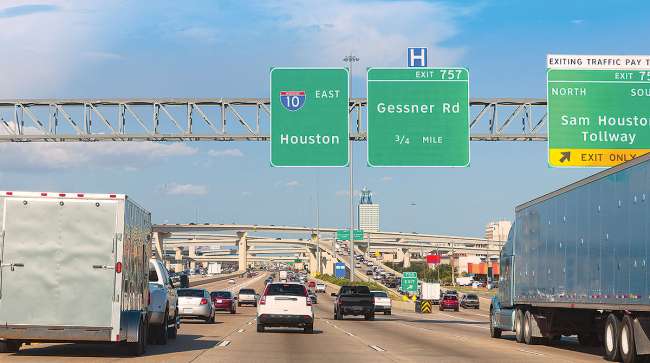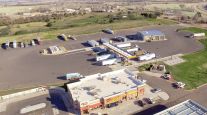Staff Reporter
FHWA Grant Supports Truck Parking Project Along I-10

The Federal Highway Administration has awarded the Texas Department of Transportation nearly $7 million to fund a truck parking availability system along Interstate 10 in four states.
I-10 stretches across the southern part of the country, running from Santa Monica, Calif., to Jacksonville, Fla. It serves as an important link for freight moving between the ports in Los Angeles and Houston.
The grant was one of a slew of awards distributed through FHWA’s Advanced Transportation and Congestion Management Technologies Deployment program.
FHWA has awarded a $6.8M ATCMTD grant to the @TxDOT for the I-10 Corridor Coalition Truck Parking Availability System, which will provide truck drivers and dispatchers real-time truck parking information at 37 locations along I-10 from California to Texas. https://t.co/k35hZcwc9s
— Federal Highway Admn (@USDOTFHWA) April 4, 2019
TxDOT applied for the grant on behalf of the other three states: Arizona, California and New Mexico. The states and the I-10 Corridor Coalition, which promotes safety for commercial and passenger vehicles, will use the funds to set up a truck parking availability detection and information sharing system across 37 public rest areas along the route. The system will make truck parking information immediately available to truckers and dispatchers.
“The idea is to make improvements for commercial travel and personal travel along I-10,” said Arizona Department of Transportation spokesman Tom Herrmann. “There are an awful lot of important markets on there and I think, from the standpoint of opening something up that’s going to help drivers in all four states, I-10 is the right choice.”
In Arizona, the grant will support signs along I-10 that digitally display information about available parking at rest areas in Bouse Wash, Burnt Well, Texas Canyon and San Simon.
Another goal for the project is to improve safety. If a trucker runs out of service hours, he or she will sometimes park in an unsafe location, such as the shoulder of a highway or ramp. Herrmann said readily available truck parking information should help drivers locate a safe place to rest. Beyond that, he said trucks parked on highways and ramps can create the need for maintenance repairs in those places.
“The primary thing is to help the truck drivers find a safe place to rest so that they’re rested when they’re on the roadway. That’s really what the goal of this is,” Herrmann said.
TxDOT spokeswoman Emily Parks said that the agency is still determining what specific technology will be used for this project. She said officials are considering various technologies, such as in-ground sensors, video detection systems and dynamic truck parking capacity signs.
John Prewitt, president of Texas-based Tideport Distributing Inc., identified interstates 10, 35, 45 and 69 as the ones his drivers travel most. Based in Channelview, Texas, just east of Houston, Tideport Distributing specializes in transporting hazardous materials, such as petroleum.
“We’re in need of more parking for trucks,” Prewitt said. “Many drivers run out of hours and they have to plan ahead for where they’re going to park and a lot of times there is no parking. The grant hopefully will help Texas as well as the other states catch up.”
Prewitt serves on the American Transportation Research Institute’s Research Advisory Committee, which unveiled its list of 2019 research priorities March 25. Developing standards for truck parking information systems based on driver preferences topped the list.
Lack of available truck parking ranked No. 5 on ATRI’s list of industry concerns, which was released Oct. 29.

Esparza
John Esparza, president of the Texas Trucking Association, said other regions, such as the eight states represented by the Mid-America Association of State Transportation Officials that developed their own information sharing program, have served as a model for truck parking projects.
ATRI President Rebecca Brewster said it’s encouraging to see states work together on truck parking solutions.
“When you think about the nature of freight movement, it’s not limited just to state borders, so it is good to see these systems crossing state lines to bring greater connectivity for systems to provide information to drivers,” Brewster said.




